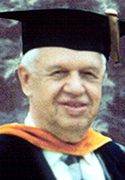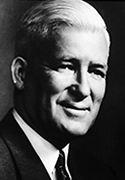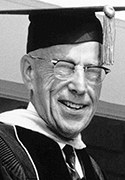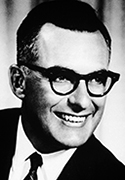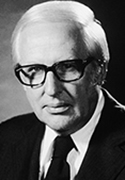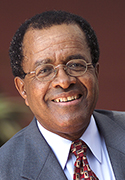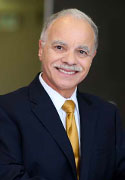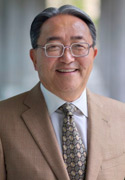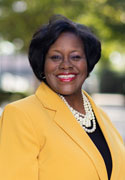1947-49: P. Victor Peterson
Los Angeles State College (LASC) opened its doors on the Vermont Avenue campus of Los Angeles City College (LACC) in August 1947.
Los Angeles State College (LASC) opened its doors on the Vermont Avenue campus of Los Angeles City College (LACC) in August 1947.
As president of LACC, P. Victor Peterson became the acting president of the state college. Peterson was on leave from San Jose State College, where he was dean of professional education, professor of chemistry and head of the natural science department. He earned his B.A. at Iowa State Teachers College in 1917, and his M.A. in 1921. He received his Ph.D. from Stanford in 1930.
Fall semester at LASC started with 225 students, but the enrollment had jumped to 1,092 by spring. Students came from every state in the union as well as Mexico, Iran and Canada. The first class of seven students graduated in 1948.
1949-62: Howard S. McDonald
In 1949, the college welcomed its second president, Howard S. McDonald, as well as the first of several name changes: Los Angeles State College of Applied Arts & Sciences (LASCAAS).
McDonald was born in Salt Lake City. In 1921, he received a B.S. from Utah State Agricultural College and earned his M.A. from University of California at Berkeley in 1925. An educator and administrator, McDonald was serving as president of Brigham Young University when he was selected to lead LASCAAS.
McDonald’s term was a time of great transition as he directed both the development of educational programs and physical expansion of the college. Officials broke ground on the current location, dubbed the Ramona site at the time, in 1955 and the first 10 buildings opened to students three years later.
McDonald retired in 1962 after 13 years at the helm of the university.
1962-63: Albert D. Graves
Albert D. Graves was vice president of Academic Affairs when he became acting president of LASCAAS in 1962. Graves held bachelor’s, master’s and doctorate degrees from Stanford University. Before coming to Los Angeles State College, he served as superintendent of the San Bernardino Schools and a professor of education at Humboldt State College.
Albert D. Graves was vice president of Academic Affairs when he became acting president of LASCAAS in 1962. Graves held bachelor’s, master’s and doctorate degrees from Stanford University. Before coming to Los Angeles State College, he served as superintendent of the San Bernardino Schools and a professor of education at Humboldt State College.
Eighty-eight new faculty appointments were made during the year that Graves served as caretaker, and the college also entered into its first contract to prepare students for the U.S. Peace Corps. The first group of 65 volunteers was trained for service in the Dominican Republic in the areas of teacher training, music teacher training and urban community action.
1963-66: Franklyn Arthur Johnson
Franklyn Arthur Johnson took over as the fourth president of Los Angeles State College in October 1963. Johnson came to the college from Jacksonville (Fla.) University, where he served as president for seven years. He received his B.S. degree magna cum laude from Rutgers University in 1947. While working on his M.A. and Ph.D. from Harvard University, he was chosen as a faculty scholar and was awarded a Fulbright scholarship for study at the London School of Economics.
Franklyn Arthur Johnson took over as the fourth president of Los Angeles State College in October 1963. Johnson came to the college from Jacksonville (Fla.) University, where he served as president for seven years. He received his B.S. degree magna cum laude from Rutgers University in 1947. While working on his M.A. and Ph.D. from Harvard University, he was chosen as a faculty scholar and was awarded a Fulbright scholarship for study at the London School of Economics.
During Johnson’s term, the football team was ranked No. 1 nationally and the campus was renamed once more to California State College at Los Angeles (CSCLA) when it became part of the California State College System in 1964.
Johnson left the college after President Lyndon B. Johnson appointed him to serve as director of the Job Corps.
1966-79: John E. Greenlee
The California State College chancellor announced John E. Greenlee as the fifth president in May 1966. Greenlee came to CSCLA as vice president for Academic Affairs in 1965. Prior to his appointment, he spent 30 years in college teaching and administration in Iowa—20 of them at Iowa State University.
The California State College chancellor announced John E. Greenlee as the fifth president in May 1966. Greenlee came to CSCLA as vice president for Academic Affairs in 1965. Prior to his appointment, he spent 30 years in college teaching and administration in Iowa—20 of them at Iowa State University.
His B.A., M.A., and Ph.D. were all earned at the University of Iowa where he majored in history and minored in education. At the post-doctoral level, he studied British history and higher education at the University of California at Berkeley.
The late 1960s and 1970s was another period of great change for the college. The campus converted to the quarter system in 1967 and established the first Chicano Studies Department in the nation in 1968. The University-Student Union, Simpson Tower and Salazar Hall were all built during this time. And in 1972, the California State College system became The California State University and Colleges (CSUC). This campus received university status and was officially known as California State University, Los Angeles—or Cal State L.A. informally—ever since.
Greenlee retired in 1979. Greenlee Plaza, located south of the Physical Sciences building, was dedicated to him.
1979-2013: James M. Rosser
James M. Rosser was selected as the sixth president in 1979. The scientist’s academic degrees, in health administration and microbiology, were conferred upon him by Southern Illinois University at Carbondale (Ph.D. 1969, M.A. 1963, B.A. 1962).
James M. Rosser was selected as the sixth president in 1979. The scientist’s academic degrees, in health administration and microbiology, were conferred upon him by Southern Illinois University at Carbondale (Ph.D. 1969, M.A. 1963, B.A. 1962).
Prior to accepting the presidency, Rosser served as deputy chancellor of the State of New Jersey Department of Higher Education. He had previously been an associate vice chancellor for Academic Affairs, and faculty member in pharmacology and toxicology, at the University of Kansas in Lawrence.
By the time Rosser was appointed in 1979, the campus had conferred degrees upon more than 85,000 students in 34 years and had an annual enrollment of nearly 29,000 and a faculty and staff of 2,700 full- and part-time employees. The campus mascot changed from Diablo to Golden Eagle in 1981, and Cal State L.A. received worldwide attention when it hosted the judo event in the 1984 Summer Olympic Games in Los Angeles.
The university landscape transformed under Rosser’s leadership. Among the projects developed by Rosser are: student housing, the Los Angeles County High School for the Arts, Marc and Eva Stern Math and Science School, the Edmund G. “Pat” Brown Institute of Public Affairs, the Anna Bing Arnold Children’s Center, the Metrolink Station, Harriet and Charles Luckman Fine Arts Complex, the Hertzberg-Davis Forensic Science Center, a new University-Student Union, the Golden Eagle building, the Wallis Annenberg Integrated Sciences Complex with La Kretz Hall, the Public Safety/University Police facility, and the Television, Film, and Media Center.
2013-2023: William A. Covino
William A. Covino was selected as the university's seventh president in 2013. Covino earned his B.A. in English from the University of California, Los Angeles. He holds M.A. degrees from CSU Northridge and the University of Southern California and earned a Ph.D. in English from USC in 1981.
William A. Covino was selected as the university's seventh president in 2013. Covino earned his B.A. in English from the University of California, Los Angeles. He holds M.A. degrees from CSU Northridge and the University of Southern California and earned a Ph.D. in English from USC in 1981.
Covino joined Cal State LA after a long career in higher education as an educator and scholar of rhetoric. He served as provost and vice president for Academic Affairs at Fresno State. He was also provost at Stanislaus State and began his career in higher education as an assistant professor at San Diego State.
During Covino's term, the university experienced a rise in national prominence and national rankings, saw improvement in student success metrics, and earned the distinction of being home to the most diverse faculty in the CSU. Over the past decade, Cal State LA has also climbed steadily and sharply in U.S. News and World Report rankings. Cal State LA jumped 73 spots among all private and public regional universities in the West over eight years.
Under his leadership, the university also launched the Center for Engagement, Service, and the Public Good; established the MindMatters initiative (now called WellBeingU); added the College of Ethnic Studies; created the Cal State LA Downtown campus; and developed the CalStateLA BioSpace incubator.
Covino retired in 2023 after a decade at the helm of the university.
2023-2024: Leroy M. Morishita
Leroy M. Morishita was appointed by the CSU Board of Trustees to serve as interim president of Cal State LA. Morishita began his tenure on July 31, 2023, and served until January 7, 2024.
Leroy M. Morishita was appointed by the CSU Board of Trustees to serve as interim president of Cal State LA. Morishita began his tenure on July 31, 2023, and served until January 7, 2024.
Morishita came to Cal State LA with more than 40 years of experience in the California State University system as an educator and administrator. From 2011 to 2020, Morishita served as president of CSU East Bay. Under his leadership, achievement at CSUEB reached new heights, with graduation and retention rates steadily increasing, while equity gaps narrowed. Morishita previously served as executive vice president for administration and finance and chief financial officer at San Francisco State University.
Morishita earned a bachelor’s degree in psychology from the University of California, Berkeley; a master’s degree in counseling at San Francisco State University; and a Doctor of Education in Administration, Planning and Social Policy from Harvard Graduate School of Education.
2024-Present: Berenecea Johnson Eanes
Berenecea Johnson Eanes was appointed by the CSU Board of Trustees to serve as president of Cal State LA. Her tenure began January 8, 2024. Eanes is Cal State LA’s ninth president and the first woman to serve in the position.
Berenecea Johnson Eanes was appointed by the CSU Board of Trustees to serve as president of Cal State LA. Her tenure began January 8, 2024. Eanes is Cal State LA’s ninth president and the first woman to serve in the position.
Eanes previously served as president of York College, City University of New York, where she provided strategic leadership and council to approximately 1,100 faculty, staff and administrators, while overseeing a $91 million budget, including endowments, fundraising and centrally administered resources. Eanes had also served as a professor in the Department of Social Work since 2019.
Her appointment as president of Cal State LA marked a return to the CSU for Eanes, who previously served as vice president for Student Affairs at California State University, Fullerton (2012 to 2019), where she delivered leadership and oversight for myriad student success programs, as well as new campus infrastructure and the university’s strategic plan.
Eanes earned a bachelor’s degree in public health from Dillard University; a master’s degree in social work from Boston University; and her doctorate in social work from Clark Atlanta University.
